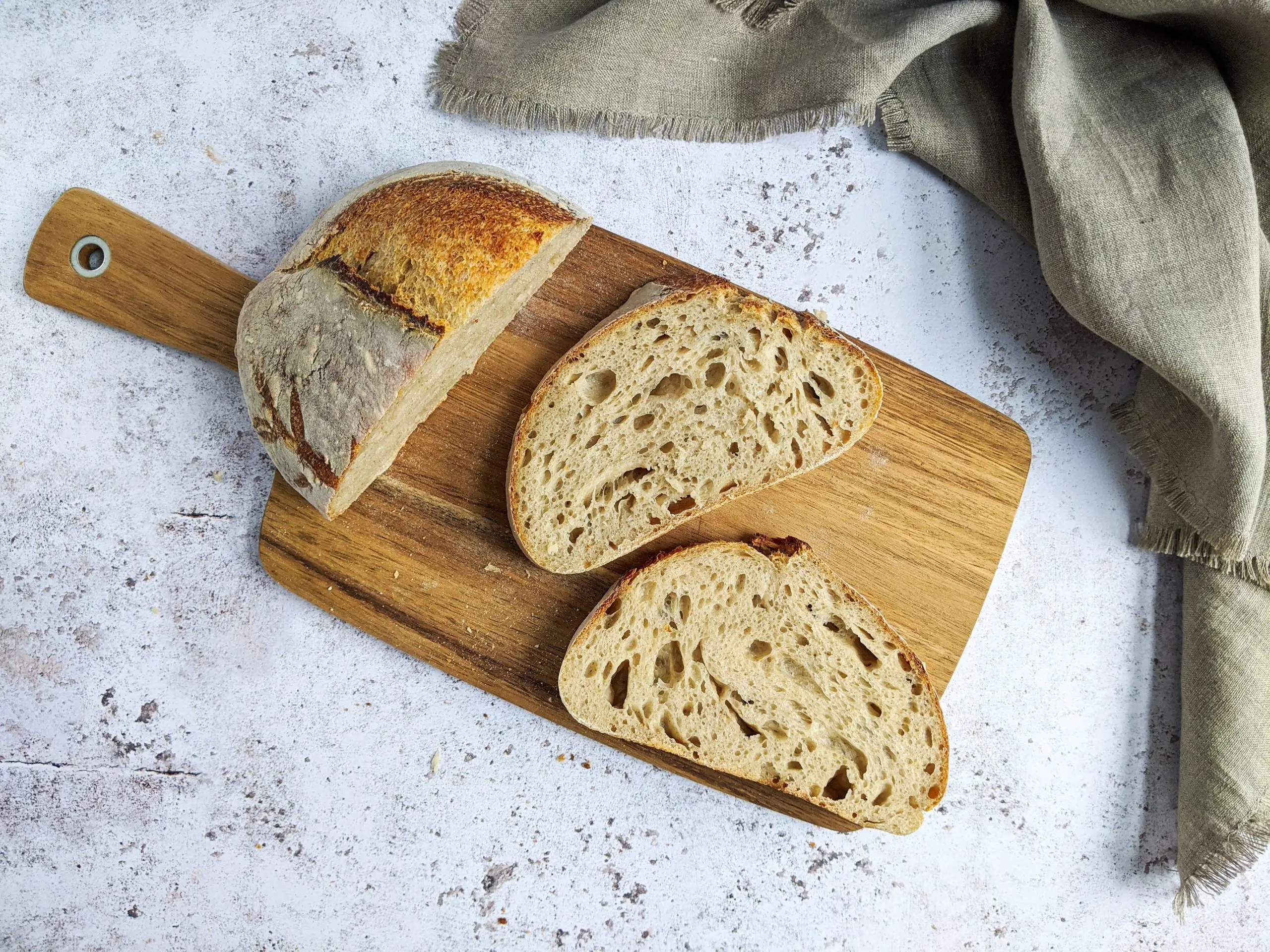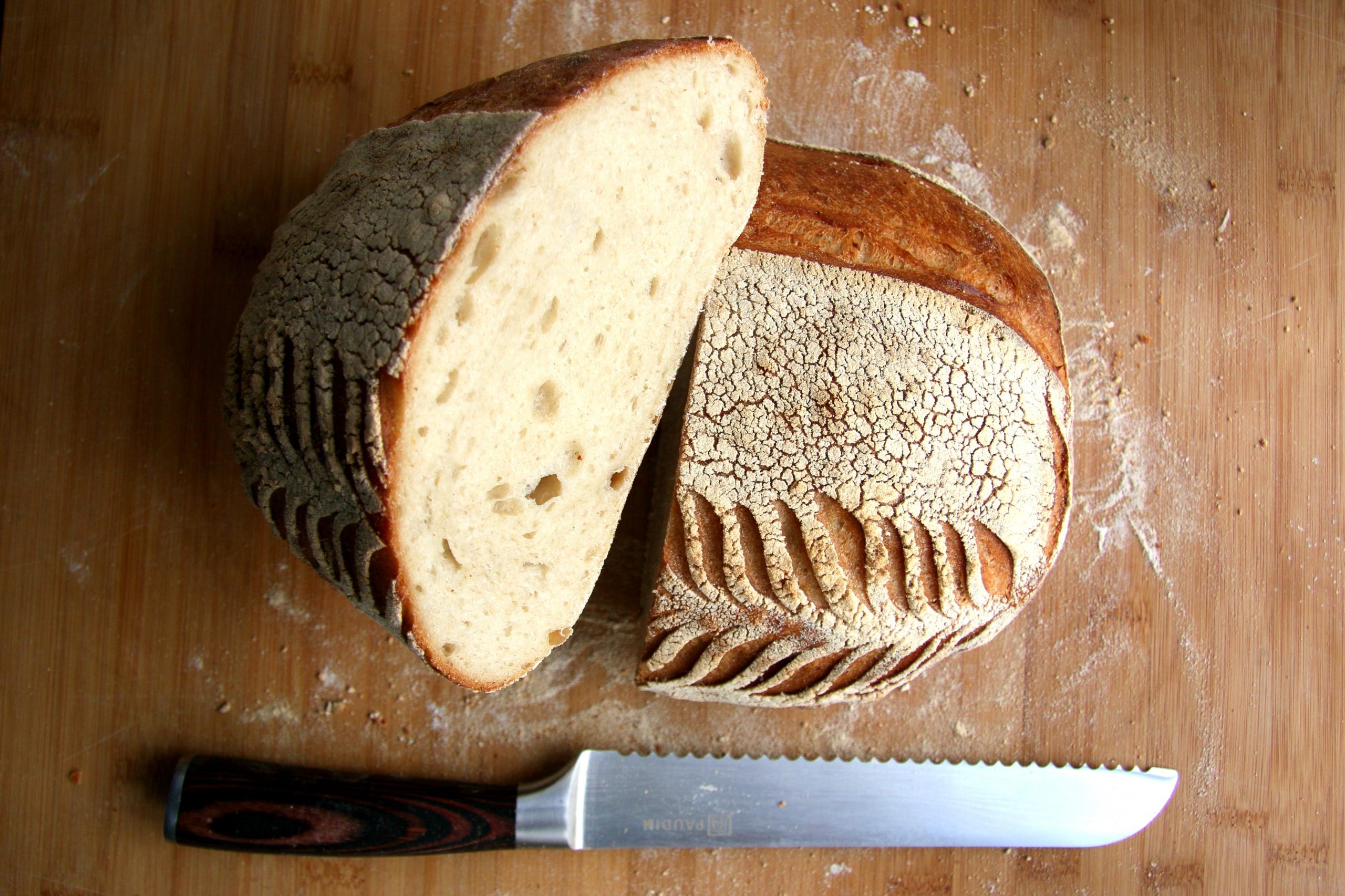Sourdough bread is a delicious treat, but it can be tricky to keep fresh. To prevent it from spoiling, you can freeze it. This will save you money and time while still giving you great-tasting bread that you’ll enjoy for a long time. Read more to find easy and quick tips for freezing sourdough bread.

How to Freeze Sourdough Bread?
You may easily place your baked sourdough bread inside a freezer-safe Ziploc bag if you intend to store it for a few days or weeks.
But to avoid ruining it, you must take out as much air as possible.
Choose a location inside the freezer that won’t cause it to be crushed once you’ve decided to put it there.
Additionally, if you intend to store it in the freezer for an extended period, you should take extra precautions to preserve your bread’s quality better.
You can adhere to the following advice:
- Make sure the bread has completely cooled to room temperature.
- Use plastic wrap to continue wrapping the entire loaf of bread.
- Now you must provide a second layer of protection by wrapping it in aluminum foil. You must make sure that every single opening is completely sealed.
- The bread can also be placed in a sizable, freezer-safe Ziploc bag with plastic and foil wrapping. Seal it up firmly after that.
- Don’t forget to write the freezing date on the bag’s label. With its aid, you can track how long it has been in the freezer.
The method discussed above will be ideal for a full loaf of bread.
Even bread that has been cut will work.
To get sliced sourdough bread, you must go in a different direction.
It’s really practical to freeze different sizes or pieces of bread separately.
It will spare you the effort of thawing an entire loaf of bread when you want to prepare a sandwich.
You can do the following:
- Your sourdough bread needs to be cut into several pieces first.
- Continue by packing one or two slices of your sourdough bread into sandwich-sized Ziploc bags. Make sure you are closing them tightly.
- Make sure they are conveniently proportioned to prevent gaps or voids from retaining air.
Not all sandwich bags are freezer-safe.
To get additional protection, you can put all the mini sandwich bags in a large freezer bag once you’ve contained them separately.
Here is a different approach for you:
- Continue to distribute them on a baking sheet. You must first spread a piece of parchment paper over your baking sheet.
- You should use plastic wrap to cover the lowest layer if there are multiple layers. Continue by immediately placing a second layer on top.
- All of the bread’s pieces should be allowed to freeze completely. Not more than an hour, ideally.
- After they have each been frozen separately, place them all inside a sizable freezer-safe Ziploc bag. They won’t stick together in this way.
- They are now ready for the freezer.
In your freezer, sourdough bread will remain fresh for over six months.
However, if you take good care of it, you can extend the time.
But just like any other frozen meal, we always suggest that you eat it as soon as possible.
Why Freeze Sourdough Bread?
An easy method to guarantee you always have sourdough on hand when you want or need it is to keep a supply of frozen sourdough bread.
The lengthy fermenting period makes making sourdough bread a laborious procedure. Baking sourdough bread daily can occasionally become challenging (though it’s not impossible) if you’re a full-time worker, a parent, or have a lot of social obligations.
If you freeze newly baked sourdough bread, it will taste just like it did when it was first cooked (unless it has been in the freezer for a very long period).
Additionally, having some frozen sliced sourdough bread in the freezer can guarantee that your week will have a little diversity.
You get the idea: a few slices of fruit bread on Monday, jalapeo cheese on Tuesday.
Is it Better to Freeze Sourdough Before or After Baking?
Both choices, in our opinion, are excellent. The decision to bake the bread before or after freezing depends more on what you have planned to do with the sourdough.
The sourdough is best frozen after baking and slicing if you want to be able to take out a few slices at a time for an occasional sandwich without having to consume the entire loaf.
On the other hand, if you prefer freshly baked sourdough and want to consume most of the loaf at once, I suggest freezing the dough and baking it right before consumption. Ultimately, it is down to your schedule and plans for using homemade sourdough.
How Long does Sourdough Bread Last Outside at Room Temperature?
Sourdough bread should normally be consumed within two to three days of purchase, but if kept on your counter in a paper bag, it will stay fresh for up to a week.
Lactobacilli, a type of bacteria that aids in the breakdown of the bread’s starches and the production of lactic acid, is found in sourdough bread. Sourdough bread lasts longer than other forms of bread because the lactic acid it contains produces an environment that is hostile to hazardous microorganisms.
Despite this, it’s still crucial to consume sourdough bread soon after purchasing it since the lactobacilli will eventually disappear, and the bread will turn nasty.
How to Use Up Extra/Leftover Sourdough Bread?
Here are a few suggestions for utilizing leftover sourdough bread:
- To make croutons, cut the bread into cubes and bake them till golden. Then, combine your preferred seasonings with olive oil.
- Mix bread cubes with celery, onions, herbs, and a little olive oil to make stuffing. Bake in the oven or place into a chicken.
- To make pudding, soak bread cubes in a liquid made of milk, cream, sugar, vanilla essence, and eggs for a few minutes. Bake in a baking dish until the top is golden and the center is firm. Hot or cold to serve.
- To make French toast, dunk bread slices in an egg mixture.
How to Freeze Sliced Sourdough?
Although it requires more work upfront, this approach has advantages. Mostly that thawing a tasty piece of frozen sourdough bread is quicker than a whole loaf! Occasionally, you need sourdough Right Now!
Instead of eating raw bread, I prefer sliced and frozen sourdough for toast.
- For at least 3 to 4 hours, let the bread cool fully at room temperature.
- Using a serrated knife, cut the sourdough into slices 12 inches thick.
- Make sure the slices are not touching as you place them on a baking sheet covered with parchment paper. Place the baking sheet in the freezer for about 30 minutes or when the pieces are frozen.
- Frozen sourdough slices should be transferred to a sizable freezer-safe bag or container.
- Put the bag back in the freezer for up to three months after adding a label and a date.
Can you Freeze Sourdough Loaf?
You can freeze sliced and full loaves of sourdough bread. Before freezing bread, you should decide how you’ll use it. You might want to freeze it in slices if you only eat a piece sometimes.
Place the entire loaf in the bag or wrap each slice in cling film before placing it in the bag.
How do you Defrost Sourdough Starter?
The process begins when it comes to defrosting your sourdough starter. It will take time before you can start baking because the yeast has to activate again.
- Place in the refrigerator
First, you must take it out of the freezer and pop it into the fridge. Don’t try to hasten this process; giving it plenty of time to defrost completely and gradually is crucial. - Remove half
Place the remaining sourdough starter in the refrigerator and discard half of it. - Feed
You must begin feeding the sourdough starter as soon as it thaws out. Feed it once or twice on the first day while it thaws out. It would be best to restart a regular feeding schedule similar to the one you used to make the starter because yeast is rather hungry, especially after hibernation. - Continue to feed
After the first day, feed it once or twice daily until you notice the bubbling indications that it is starting to act normally once more. - Take your time
When the starter appears steady and has grown, it is time to use your sourdough starter. When you take it out of the freezer, this could take a few days.
Does Sourdough Starter Freeze Well?
Because a sourdough starter contains living yeast, it may seem counter-intuitive that it would freeze nicely. It is a difficult operation because you must pay close attention to the yeast as you thaw it out, and there is always a chance that you will destroy some of the yeast.
However, freezing it is well worth the effort if the only other choice is to discard it.
How Long will Frozen Sourdough Last?
After a few weeks, the quality of sourdough frozen in nothing but a plastic bag will start to deteriorate.
Bread may develop ice crystals if the bag is not properly airtight, affecting the bread’s flavor and texture as it defrosts. When freezing sourdough, it’s crucial that you securely seal your bread bag.
It should be safe to store bread in your freezer for several months if you double-wrap it as advised and ensure the seal is watertight. Aim to consume it within six months.
Conclusion
Making sourdough bread is simple and rather tasty.
It also contains a tonne of antioxidants, including peptides, which lower the risk of getting rheumatoid arthritis, cancer, and other diseases.
In comparison to other bread, the human body also considers this bread to be simpler to digest.
The bread’s chewy and crunchy texture and tangy flavor make it the perfect accompaniment to almost any cuisine.
This bread takes a long time to make, but it tastes amazing.
You can begin baking them yourself and storing them in the freezer for later use.
